Ansible自动化部署安装openGauss 3.1.0 企业版
szrsu openGauss 2022-11-25 17:31 发表于广东
一、背景
由于IT建设的快速发展,当数据中心业务突增,需要快速部署多套的数据库时,给运维工作带来了不小的压力和挑战,作为运维人员该如何面对这种困境呢?另外由于个人的习惯等也会导致所部署的环境不一定与规划完全一致,那么对以后的运维也会产生一定的负面影响。很显然,这种传统的方式已经无法适应当前的情景了,自动化运维应运而生,ansible在自动化运维和devops 的应用中崭露头角。
本文基于ansible工具实现 openGauss 的一键批量部署,传统的部署方式是先修改系统配置、安装依赖包、创建omm用户和组、配置环境变量、上传安装包以及解压、安装等步骤。
按照这个流程和思路,我们把这些操作弄成剧本编排(playbook),交给ansible来做。
二、环境准备
2台主机: 一台为Ansible的管理主机(10.10.10.142),操作系统为CentOS Linux release 7.9.2009 (Core); 另外一台为需要部署openGauss的主机(10.10.10.150),操作系统为CentOS Linux release 7.9.2009 (Core)。
三、具体实施步骤
3.1、安装ansible
–在10.10.10.142上进行安装Ansible yum install epel-release -y yum install ansible –y
–配置/etc/ansible/ansible.cfg
# grep -v '^#' /etc/ansible/ansible.cfg |sed '/^$/d' [defaults] host_key_checking = False callback_whitelist = timer,profile_roles,log_plays log_path = /var/log/ansible.log strategy = free bin_ansible_callbacks = True [inventory] [privilege_escalation] [paramiko_connection] [ssh_connection] [persistent_connection] [accelerate] [selinux] [colors] [diff] [callback_log_plays] log_folder=/tmp/ansible/hosts/
3.2、配置主机清单
修改主机清单/etc/ansible/hosts,添加主机列表
# cat /etc/ansible/hosts [openGaussdb] 10.10.10.150 ansible_ssh_user=root ansible_ssh_pass=123456
10.10.10.150为本次需要安装openGauss的主机
3.3、测试主机连通性
# ansible -i /etc/ansible/hosts openGaussdb -m ping
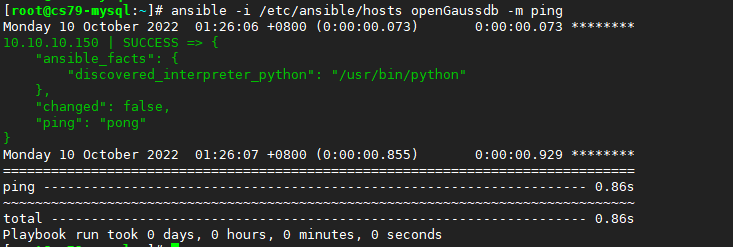
3.4、创建相关目录
[root@cs79-mysql:~]# cd /etc/ansible/roles/ [root@cs79-mysql:/etc/ansible/roles]# mkdir -p openGauss_Install/{files,vars,tasks,templates} [root@cs79-mysql:/etc/ansible/roles]# tree openGauss_Install/ openGauss_Install/ ├── files ├── tasks ├── templates └── vars
4 directories, 0 files
上述目录主要作用如下: files:存放需要同步到异地服务器的安装文件或者配置文件; tasks:openGauss安装过程需要进行的执行的任务; templates:用于执行openGauss安装的模板文件,一般为脚本; vars:安装openGauss定义的变量;
3.5、下载openGauss软件包到files目录
安装包下载地址:https://opengauss.org/zh/download.html
[root@cs79-mysql:/etc/ansible/roles]# cd openGauss_Install/files/ [root@cs79-mysql:/etc/ansible/roles/openGauss_Install/files]# # wget https://opengauss.obs.cn-south-1.myhuaweicloud.com/3.1.0/x86/openGauss-3.1.0-CentOS-64bit-all.tar.gz –2022-10-09 21:42:01-- https://opengauss.obs.cn-south-1.myhuaweicloud.com/3.1.0/x86/openGauss-3.1.0-CentOS-64bit-all.tar.gz Resolving opengauss.obs.cn-south-1.myhuaweicloud.com (opengauss.obs.cn-south-1.myhuaweicloud.com)… 121.37.63.38, 139.159.208.64, 139.159.208.243 Connecting to opengauss.obs.cn-south-1.myhuaweicloud.com (opengauss.obs.cn-south-1.myhuaweicloud.com)|121.37.63.38|:443… connected. HTTP request sent, awaiting response… 200 OK Length: 123022609 (117M) [application/gzip] Saving to: ‘openGauss-3.1.0-CentOS-64bit-all.tar.gz’
100%[==================================================================================================================================================================================================>] 123,022,609 38.4MB/s in 3.2s
2022-10-09 21:42:04 (37.1 MB/s) - ‘openGauss-3.1.0-CentOS-64bit-all.tar.gz’ saved [123022609/123022609]
3.6、创建变量文件
[root@cs79-mysql:~]# vi /etc/ansible/roles/openGauss_Install/vars/main.yml
#安装包名称 openGauss_software: openGauss-3.1.0-CentOS-64bit-all.tar.gz #解压目录 install_dir: /opt/software/openGauss #omm用户密码 omm_password: openGauss@123 #数据库密码 db_password: openGauss@123
3.7、创建安装时需要的xml模板
[root@cs79-mysql:~]# vi /etc/ansible/roles/openGauss_Install/templates/cluster_config.j2
<?xml version="1.0" encoding="UTF-8"?>
<ROOT>
<!-- openGauss整体信息 -->
<CLUSTER>
<!-- 数据库名称 -->
<PARAM name="clusterName" value="dbCluster" />
<!-- 数据库节点名称(hostname) -->
<PARAM name="nodeNames" value="{{ ansible_hostname }}" />
<!-- 数据库安装目录-->
<PARAM name="gaussdbAppPath" value="/opt/huawei/install/app" />
<!-- 日志目录-->
<PARAM name="gaussdbLogPath" value="/var/log/omm" />
<!-- 临时文件目录-->
<PARAM name="tmpMppdbPath" value="/opt/huawei/tmp" />
<!-- 数据库工具目录-->
<PARAM name="gaussdbToolPath" value="/opt/huawei/install/om" />
<!-- 数据库core文件目录-->
<PARAM name="corePath" value="/opt/huawei/corefile" />
<!-- 节点IP,与数据库节点名称列表一一对应 -->
<PARAM name="backIp1s" value="{{ inventory_hostname }}"/>
</CLUSTER>
<!-- 每台服务器上的节点部署信息 -->
<DEVICELIST>
<!-- 节点1上的部署信息 -->
<DEVICE sn="1000001">
<!-- 节点1的主机名称 -->
<PARAM name="name" value="{{ ansible_hostname }}"/>
<!-- 节点1所在的AZ及AZ优先级 -->
<PARAM name="azName" value="AZ1"/>
<PARAM name="azPriority" value="1"/>
<!-- 节点1的IP,如果服务器只有一个网卡可用,将backIP1和sshIP1配置成同一个IP -->
<PARAM name="backIp1" value="{{ inventory_hostname }}"/>
<PARAM name="sshIp1" value="{{ inventory_hostname }}"/>
<!--dbnode-->
<PARAM name="dataNum" value="1"/>
<PARAM name="dataPortBase" value="26000"/>
<PARAM name="dataNode1" value="/opt/huawei/install/data/dn01"/>
<PARAM name="dataNode1_syncNum" value="0"/>
</DEVICE>
</DEVICELIST>
</ROOT>
3.8、创建任务文件
[root@cs79-mysql:~]# vi /etc/ansible/roles/openGauss_Install/tasks/main.yml
- name: 关闭防火墙
shell: systemctl disable firewalld.service && systemctl stop firewalld.service
ignore_errors: true
tags: 01_os_syscfg
- name: 关闭selinux
shell: sed -i 's/SELINUX=enforcing/SELINUX=disabled/g' /etc/selinux/config
ignore_errors: true
tags: 01_os_syscfg
- name: 设置时区
shell: timedatectl set-timezone Asia/Shanghai
tags: 01_os_syscfg
- name: 关闭RemoveIPC
lineinfile:
path: /etc/systemd/logind.conf
state: present
line: "RemoveIPC=no"
tags: 01_os_syscfg
- name: 重启systemd-logind服务
shell: systemctl daemon-reload && systemctl restart systemd-logind
tags: 01_os_syscfg
- name: 创建组
group: name=dbgrp gid=2000
tags: 02_user_add
- name: 创建用户
user:
name=omm uid=2000 group=dbgrp
tags: 02_user_add
- name: 修改密码
shell: echo "{{omm_password}}" | passwd --stdin omm
tags: 02_user_add
- name: 新建目录
file: path="{{item}}" state=directory mode=0755 owner=omm group=dbgrp
with_items:
- /opt/software/
- /opt/software/openGauss
tags: 03_unzip_db
- name: 上传安装包
copy: src={{openGauss_software}} dest={{install_dir}} owner=omm group=dbgrp mode=0644
tags: install
tags: 03_unzip_db
- name: "解压软件包"
shell: cd {{install_dir}} && tar -zxvf *all.tar.gz && tar -zxvf *om.tar.gz
become: yes
become_user: omm
tags: 03_unzip_db
- name: "安装依赖包"
yum: name="libaio-devel,flex,bison,ncurses-devel,glibc-devel,patch,redhat-lsb-core,python3,bzip2,readline-devel,net-tools,tar,gcc,gcc-c++" state=installed
tags: 04_os_yum
- name: 替换python3版本
shell: mv /usr/bin/python /usr/bin/python2_bak && ln -s /usr/bin/python3 /usr/bin/python && python -V
tags: 05_replace_py
- name: 配置xml文件
template: src=cluster_config.j2 dest={{install_dir}}/clusterconfig.xml
tags: 06_config_xml
- name: 执行预安装脚本
shell: '{{install_dir}}/script/gs_preinstall -U omm -G dbgrp -X {{install_dir}}/clusterconfig.xml --non-interactive'
register: preinstall
tags: 07_pre_install
- debug: var=preinstall.stdout_lines
ignore_errors: true
tags: 07_pre_install
- name: 检查预安装环境
shell: '{{install_dir}}/script/gs_checkos -i A -h {{ ansible_hostname }} --detail'
register: checkos
tags: 08_check_os
- debug: var=checkos.stdout_lines
ignore_errors: true
tags: 08_check_os
- name: 更改权限
shell: chmod -R 755 {{install_dir}}
tags: 09_gs_install
- name: 执行gs_install
shell: su - omm -c "{{install_dir}}/script/gs_install -X {{install_dir}}/clusterconfig.xml --gsinit-parameter="--pwpasswd={{db_password}}""
register: gsinstall
tags: 09_gs_install
- debug: var=gsinstall.stdout_lines
ignore_errors: true
tags: 09_gs_install
- name: 启动数据库
shell: ss -anpt|grep 26000 && su - omm -c "gs_ctl restart " || su - omm -c "gs_om -t start "
tags: 10_db_start
- name: "登录数据库"
shell: ss -anpt|grep 26000 && su - omm -c "gsql -d postgres -p26000 -r -l"
tags: 10_db_start
3.9、创建剧本调用文件
[root@cs79-mysql:~]# vi /etc/ansible/playbook/InstallopenGauss.yml - name: Install openGauss hosts: openGaussdb remote_user: root roles: - openGauss_Install
四、执行自动化安装
4.1、校验语法
# ansible-playbook -C /etc/ansible/playbook/InstallopenGauss.yml
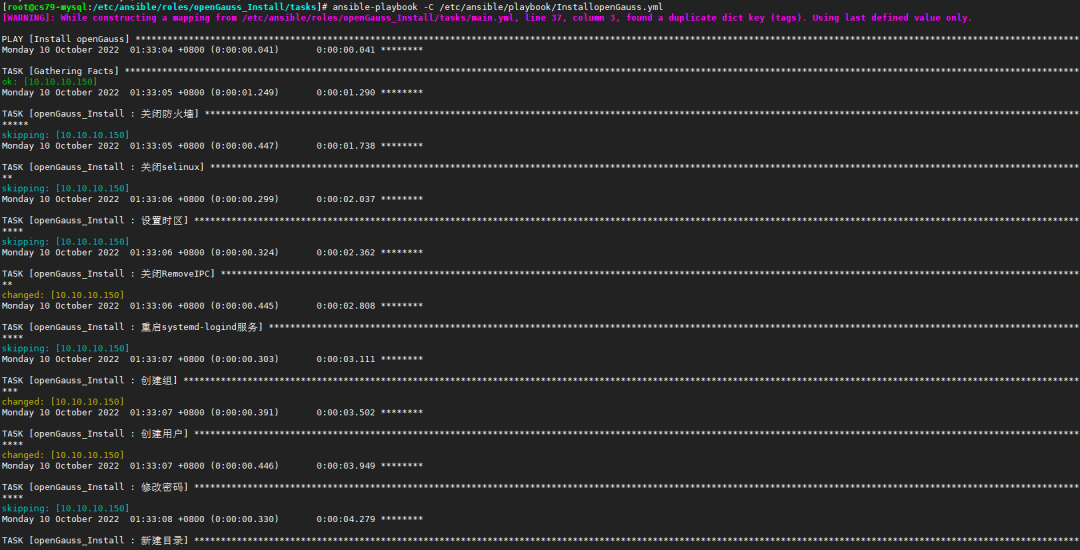
校验语法通过后,执行下一步安装
4.2、自动化安装openGauss
# ansible-playbook /etc/ansible/playbook/InstallopenGauss.yml
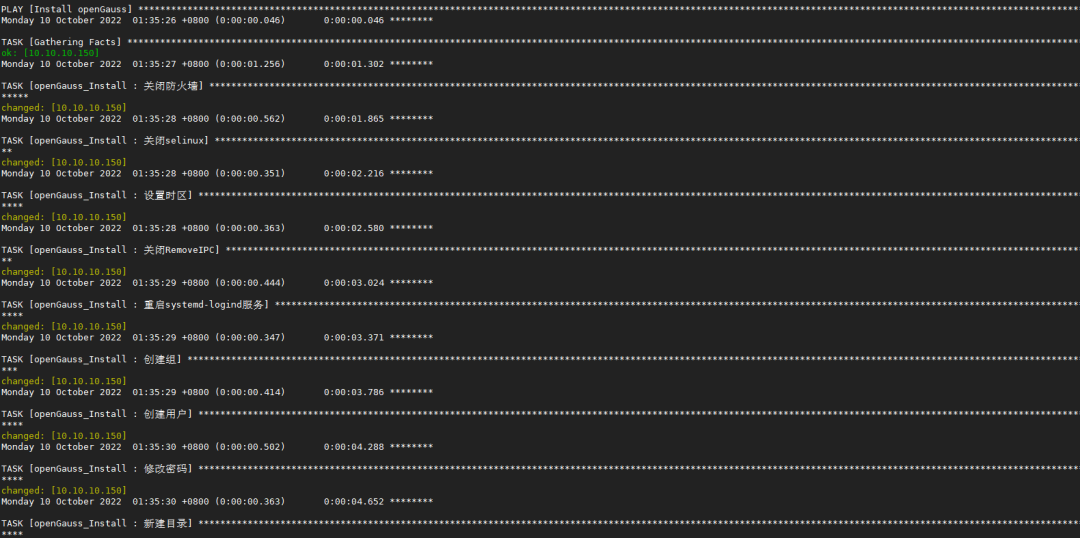
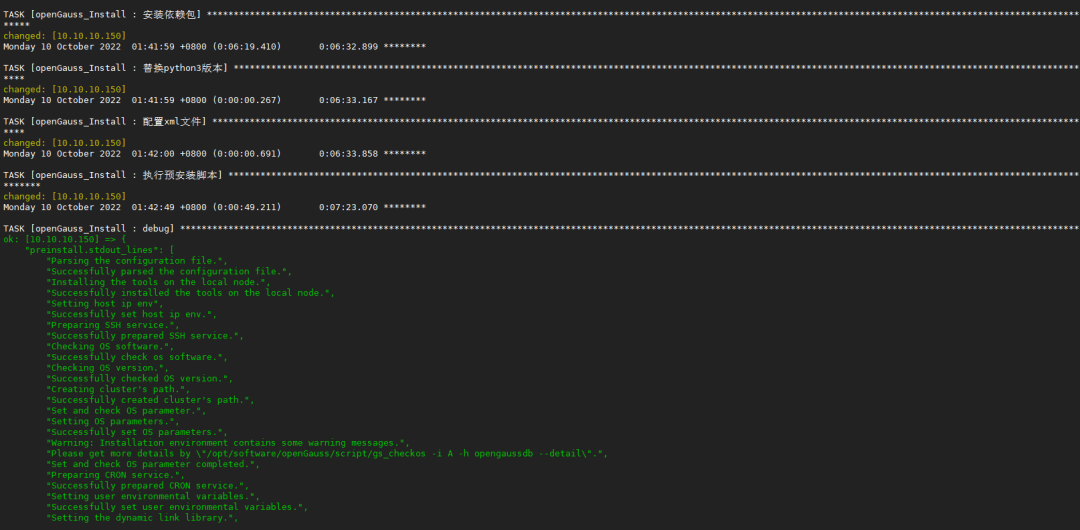
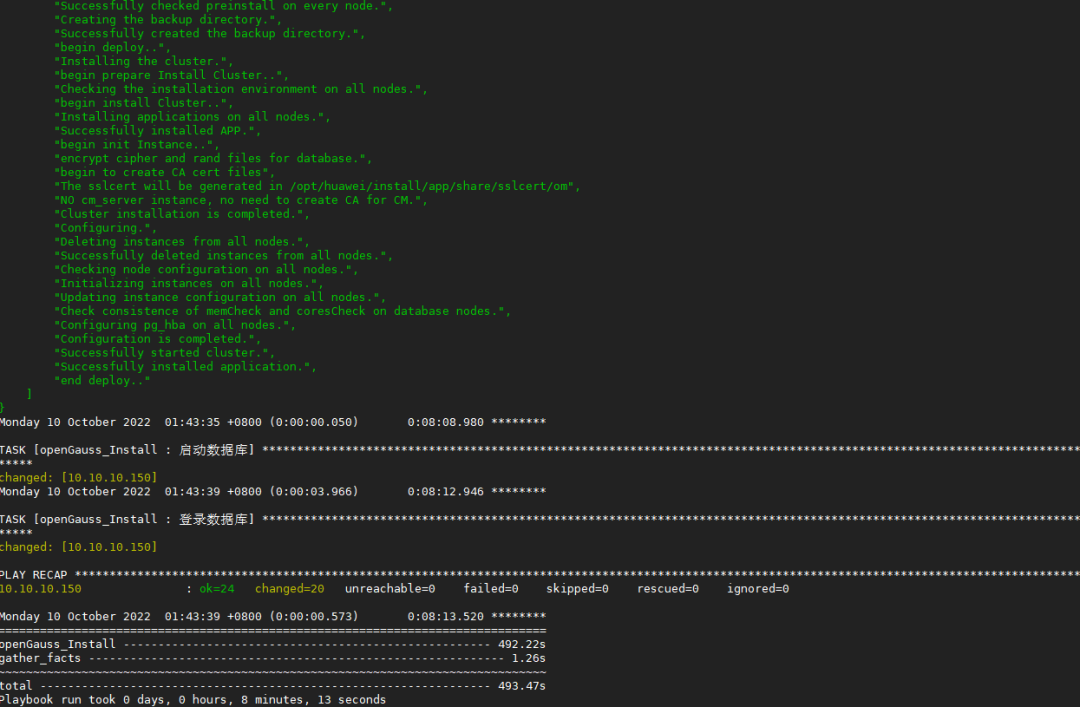
4.3、安装完成后验证
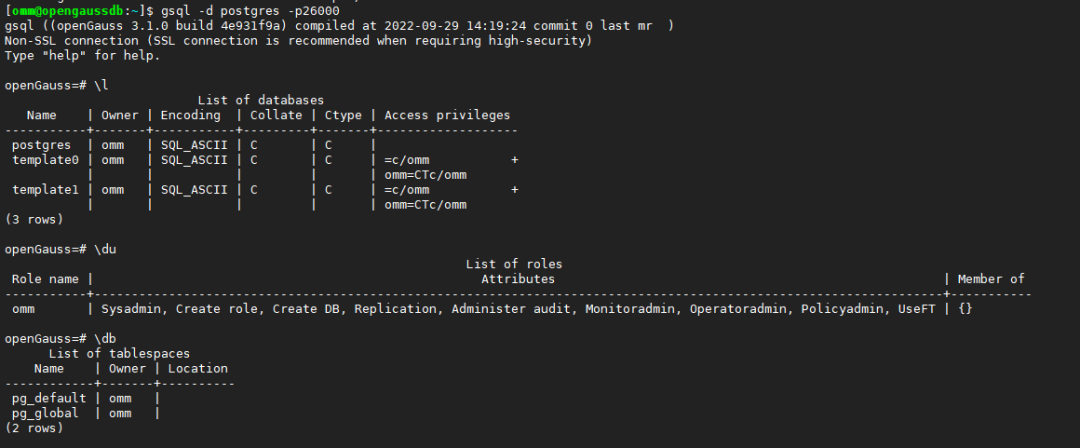
至此,整个自动化部署openGauss完毕,如果有多台机器需要部署,添加主机相关信息到/etc/ansible/hosts,再执行ansible-playbook即可。




















 1853
1853

 被折叠的 条评论
为什么被折叠?
被折叠的 条评论
为什么被折叠?








